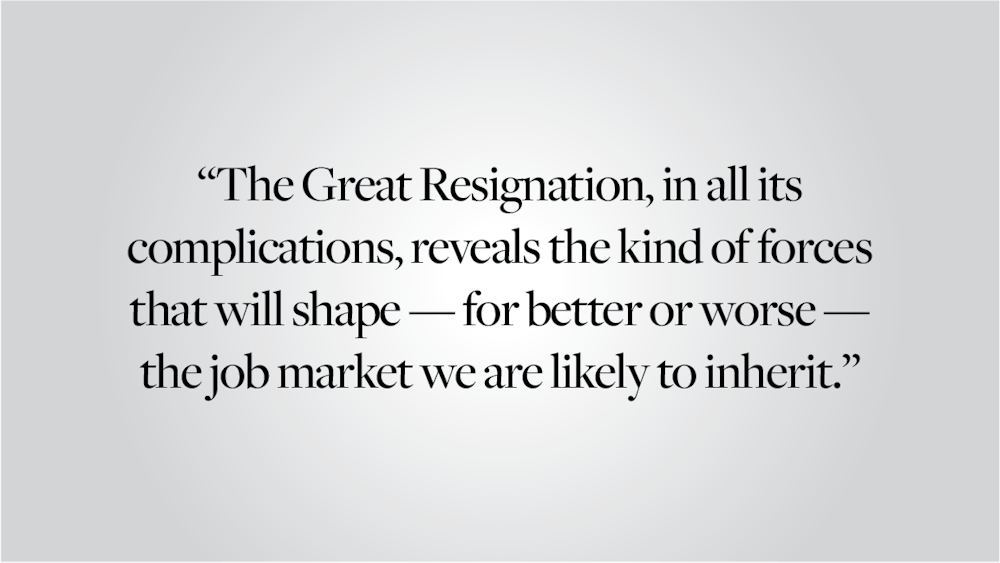“Sorry, we’re short-staffed.” Over the past two years, I’ve heard those words countless times, seen them on signs in cafes, bookstores, even doctors’ offices. They’re words I’ve said myself, leaving customers waiting at the door while I scramble to balance hostessing and serving pizzas at the same time. Through supply chain shortages, health risks for front-line workers and inflation, COVID-19 has strained industries in the country, causing intense burnout and revealing systemically poor workplace conditions that long preceded it. The fallout from the pandemic is causing millions of American workers to quit en masse in a wave of two-week notices known as the “Great Resignation.” Since April 2021, about a fifth of the U.S. workforce has left their jobs. In November alone, 4.5 million people resigned. These resignations are especially high in the hospitality and service industries. Still, people in every sector of the economy, from retail to tech, have also been calling it quits. In business journals and news articles alike, the Great Resignation has been characterized as a turning point for American workers — a widespread demand that employers provide higher wages and greater benefits in order to attract and retain employees. But I fear that the dominant narrative surrounding the Great Resignation obscures the more troubling reality of the COVID economy –– one where the wealthy have consolidated their power in a way that spells trouble for workers in the future.
The Great Resignation has become a buzzword of the pandemic era, and there’s good reason for the fascination. In stunning numbers, employees are challenging salaries, benefits and the notion that they are beholden to their employers. In what has been described as a “shift in sentiment and attitudes” toward a more sustainable work-life balance, the conditions of the pandemic have sharpened worker grievances in a way that is causing people to not only quit but also organize. Unionization efforts and labor organizations are gaining both visibility and momentum — public support of unions is at its highest in over 50 years. Large corporations like Starbucks are facing mounting pressure from employees to raise salaries. These trends aren’t just unfolding in traditional workplaces but also in academia. At Columbia, graduate students underwent the longest higher education strike in recent memory. And on Brown’s campus, reports of outdated facilities and understaffing exacerbated by COVID led to an advocacy movement calling for better conditions for Brown Dining Services workers last fall. The sentiment that workers deserve better is driving both organized protest and individual resignation. There’s a kind of catharsis in saying “I quit” in particular. It’s an acknowledgement of personal ownership over our jobs and lives in a time when so much is horribly, terrifyingly out of control. But the scope of that control is not entirely clear.
While there has undeniably been a shift in the way we conceptualize labor, the Great Resignation is hardly the simple, power-to-the-people story promoted by the media. Movements to quit, strike or boycott in response to lacking wages and conditions may be better publicized now, but they aren’t a definitive win for unions or workers at large — actual membership in unions continued to decline in 2021. Additionally, many of the reasons for resignation are less empowering than the storyline of a “nationwide awakening” would suggest. For instance, resignations are not distributed equally across gender. Women are leaving the workplace at twice the rate of men. These departures aren’t isolated; they’re often due to pressing material factors that disproportionately affect women, such as an inability to pay for child care. Many of the people being considered part of the Great Resignation are actually mothers who feel that they have no options besides leaving work. It’s a trend that reveals more about the deep failures of the country’s welfare system than about any particular leverage or self-actualization on the part of working women.
American workers may be shifting their own career trajectories, but their power in the grand scheme of the economy has not improved. In fact, wealth inequality in the United States is actually getting much worse. Billionaires globally amassed $3.6 trillion in 2020 while over 100 million people fell into extreme poverty. Likewise, massive corporations like Amazon have flourished over the past two years while countless small and mid-sized companies have suffered and, ultimately, shuttered. The consolidation of wealth and hiring power in the hands of corporate titans is alarming. A concentrated economy is a less competitive economy for employers, meaning wages could likely become less competitive as well. If COVID-19 continues to constrict the number of employers in the job market, it’s difficult to imagine that employees would have the leverage to negotiate for increased benefits, fairer hours and decent working conditions.
I raise these points not to downplay the recent accomplishments of labor movements, nor to discourage people from seeking to redefine their professional lives, but rather to urge against complacency with the state of the economy and the opportunities we have to participate in it. Students in particular should pay attention to these dynamics. The Great Resignation, in all its complications, reveals the kind of forces that will shape — for better or worse — the job market we are likely to inherit. COVID-19 has made clear the value of everyday labor in coffee shops, hospitals and hotels. But recognizing the value of that labor does not mean enough is being done to protect it. We have to also recognize and resist the more insidious forces at work.
Alissa Simon ’25 can be reached at alissa_simon@brown.edu. Please send responses to this op-ed to letters@browndailyherald.com and op-eds to opinions@browndailyherald.com.





